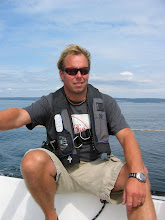Got a bit more done today. Most of it what I got accomplished is below deck. Where the cockpit
floor panels meet the cockpit side panels, a bit of work had to be done to strengthen the joint. First I had to sand the sharp edge where the two surfaces met smooth and give it a nice rounded profile. Then I glassed it with 4" tape, and then a second layer of 6" tape. (The flash from my camera makes it look like I've got a lot of dry spots in the tape--they aren't really there..really!) I also added a couple layers of tape around the base and top of the rudder box. I also added a strip on the top edge of starboard hull and sanded it at the correct angle to receive the deck. Lastly I cut the remaining cockpit deck stringers, notched them and dry fit them into postion. If I get time to work on the boat next week, I should be able to start decking the cockpit area.



